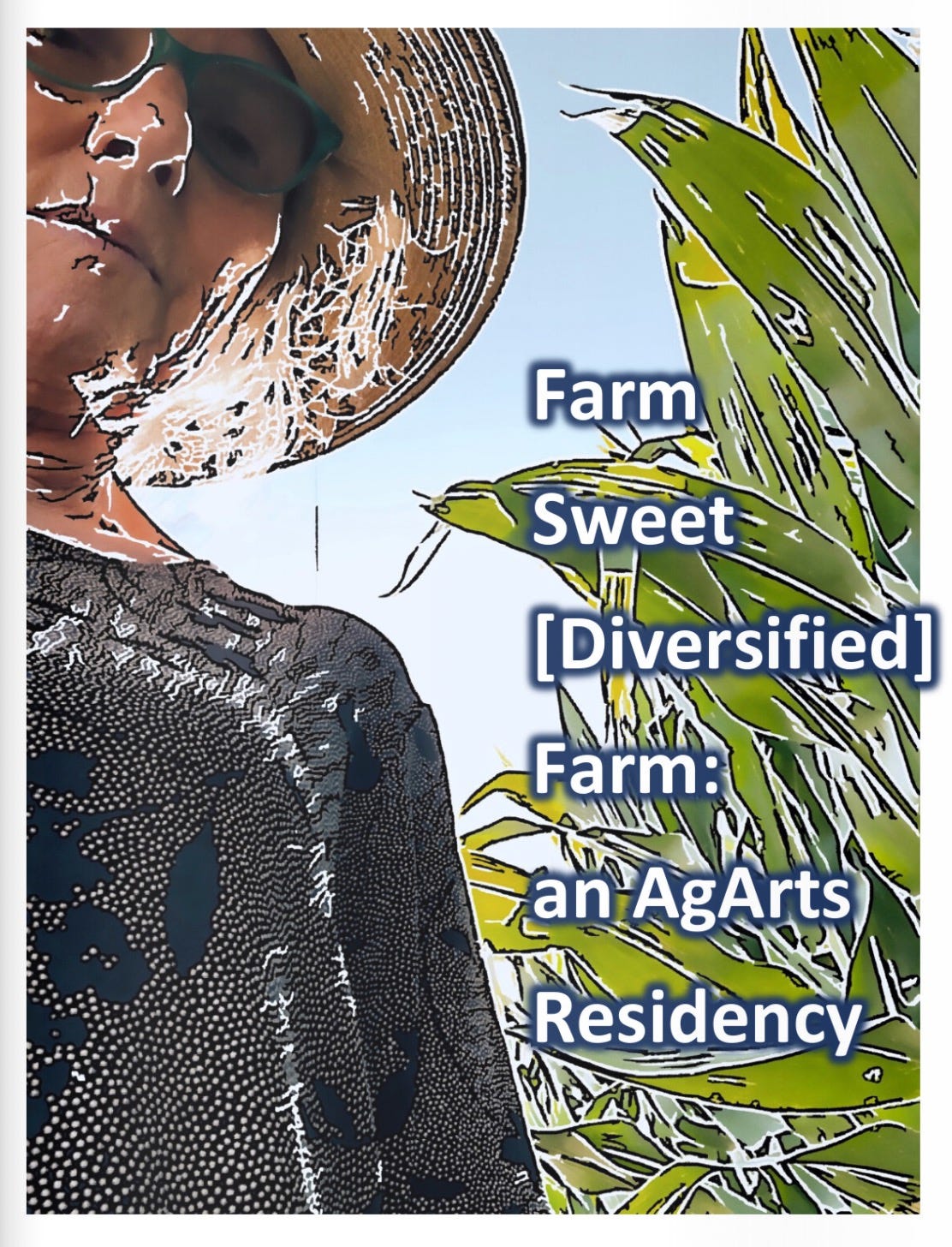This week’s column, written by Karen Downing, was originally published in Macey Shofroth’s Substack page The Midwest Creative on July 28, 2024.
Interested in an AgArts residency, either as an artist or farmer? Go to the AgArts website for information and an application.
AgArts is a 501 c3 non-profit and runs on tax-deductible donations. Would you like to support our work? Click the “Donate” button on the AgArts website, or become a paid subscriber of Mary Swander’s Emerging Voices:
Miles from the nearest town. Corn fields everywhere. The vastness of the sky. The crushing presence of the stars in inky darkness. And even more corn.
Traveling into the unfamiliar Iowa landscape allowed Buzz Masters, an artist from Maine in Iowa for an AgArts residency, to step out of her known world. “There is a definite Midwest culture and rhythm not at all like the East coast. As I traveled to the residency housing, I could feel the world fall away, the landscape change,” says Masters. “Everything in Iowa appears far away, spread apart on the long, low, horizon. No matter how fast you drive, you never seem to get closer to that division of land and sky.”
This sense of disequilibrium is exactly what Mary Swander, Iowa Women’s Hall of Fame Honoree and Iowa State University professor and writer, hoped for when she founded the AgArts farm-to-artist residencies.
The idea? Take artists out of their familiar environment and place them in a one to two week residency to learn about sustainable agriculture and provide time and space to do their imaginative work. For farmers hosting artists, the artists can offer new modes of seeing and allow farmers a chance to educate people about rural life.
Twenty five artists in the past five years have participated in residencies, namely in Iowa and Nebraska. Each residency is unique and allows the artist to create in an expansive way.
Annie Chapman Brewer wrote a composition using horn and wildlife sounds after her residency at Whiterock Conservancy. Jean Graham created a zine after her time at a farm in southeast Iowa. The Connemara Lads came from Ireland to Iowa and wrote music about the New Hope Farm in La Motte before touring around the state, including a stop to see the Bridges of Madison County.
Eleanor Goudie-Averill, dance artist and educator, spent a week at Whiterock Conservancy in residence with her mother (a freelance writer and book reviewer), her father (a fiction writer) and her brother (a cellist).
“The AgArts residency was the first time we'd intentionally come together as artists to share our practices, “says Goudie-Averill. “We worked on our own projects, sharing our processes and getting feedback, and created some new work. My brother and I worked with some of our dad's poems to create a song cycle of sorts in the old dance barn and our mom provided critical feedback.”
Goudie-Averill has attended many residencies, and every residency program has its unique features. “For AgArts, it's the opportunity to use the space for needed projects, and projects that are close to your heart, rather than having to tailor your project to the desires of the organization. It's also the physical spaces themselves, vast and open and full of beautiful potential,” says Goudie-Averill.
The arts can be used as a catalyst for exploring sustainable farming, a topic of growing interest in Iowa. Jean Graham said her residency week at the Geyer Farm/Land Alliance Folk School in Oxford rekindled her love of the land, increased her understanding of rural Iowa and inspired a new direction in her creative work.
Nancy Meyer, a farmer in Nebraska, wanted to host an artist to help people see that you can grow your own food and live sustainably with whatever resources you have. And that not all “farming” is driving big machinery and wearing feed caps.
Swander said in her travels as a writer, she realized how prevalent the rural/urban divide was. “I wanted to do something to change this picture,” says Swander. In times of polarization, art can build connections in unexpected ways, providing healing and understanding.
For Buzz Masters, the landscape around Whiterock Conservancy provided solace. “I left behind my busy life to paint, and after my initial check in with the property caretaker, I was alone except for the company of two owls who gave me a nightly serenade while sitting on a tree by the front door. It was comforting to have the landscape around me ordered and precise, “says Masters. “While I am not a landscape painter, this definitely influenced my work as I put that low horizon in the paintings I made while in residency. AgArts gave me that freedom to experiment.”
Now that the pandemic has calmed, Swander hopes to live more fully into her desire to have artists come from all around the country and the world for AgArts residencies. Future residencies include an oral historian and audio artist coming to New Hope to document a community garden set up for Guatemalan immigrants. This farm, a Catholic Worker Farm, uses sustainable practices and stewardship in a spirit of hospitality, just the place for an artist to visit.
To learn more about AgArts, visit: agarts.org
Mary Swander’s Emerging Voices is part of the Iowa Writers Collaborative. Browse our wide-ranging work through the Sunday Round-Up with a free or paid subscription.







Great article, Mary. The AgArts Residency at Whiterock Conservancy is a great way to connect art and nature, both mentally and physically. Russ Mullen
So thoughtful and inspiring! The images are beautiful and do give the viewer new eyes.